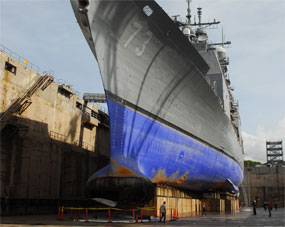Port Royal Grounding, Follow-Up
Divers from the State of Hawaii Department of Land and Natural Resources and the U.S. Navy have been working cooperatively over the course of this week to assess the extent of the grounding scar from USS Port Royal (CG 73) and to undertake emergency restoration activities on the impacted reef.
Meanwhile, the guided-missile cruiser entered drydock at Pearl Harbor Naval Shipyard Feb. 18 to repair damage sustained when it ran aground the night of Feb. 5 a half-mile off Honolulu Airport's Reef Runway. After three unsuccessful attempts, the Pearl Harbor ship was refloated early Feb. 9.
An assessment of the damage to the ship and the repair efforts that will be needed are ongoing.
Back in the water, state DLNR representatives and Navy divers are making good progress in initial restoration efforts.
"Although initial reports indicated that the ship had grounded on a rock and sand bottom, our subsequent surveys have shown that there is in fact coral reef," said Laura H. Thielen, DLNR chairperson.
"Divers from our Division of Aquatic Resources (DAR) are now working in cooperation with counterparts from the Navy to ensure that no further damage occurs, and to map the full extent of the grounding scar."
DAR divers have been in the water since Feb. 12 conducting an underwater survey of the grounding site. Divers from the Pearl Harbor-based Mobile Diving and Salvage Unit (MDSU) 1 are continuing to support the state's efforts and already have spent hundreds of man-hours at the scene on actions that include tagging and replacing broken coral blocks.
Over the course of this week, both Navy and state divers are concentrating on mapping and photographing the extent of the damage to identify coral colonies that might be reattached to the reef using quick-setting cement.
"The Department of Land and Natural Resources' previous experience with other similar groundings, such as the Cape Flattery at Barbers Point and the Casitas in the Northwestern Hawaiian Islands, has allowed us to develop proven underwater mapping and survey methods that have been brought to bear on the current incident," said Thielen.
Divers also are noting the locations of detached reef blocks or other debris that might roll in the surf and cause additional damage to the reef over time. These are being removed by Navy divers specially trained in underwater salvage operations and disposed of at a deep water site approved by the DAR. The largest broken blocks are being cemented in place in order to stabilize them and prevent further movement.
As many as 42 Sailors a day from MDSU 1 have been assisting the state effort, not only moving to deeper water rocks that range from two to five feet in diameter, but also helping state biologists reattach large pieces of coral.
The state estimates its initial assessment phase will take up to two weeks to complete. Discussions are underway with the Navy regarding any subsequent actions.
After reviewing the ship's records, the Navy has informed the state Department of Health that Port Royal discharged approximately 7,000 gallons of wastewater while the ship was aground, to prevent it from backing up and endangering the crew. The wastewater in this case consisted mostly of seawater, which is used to flush waste aboard Navy ships. Restoration efforts in the vicinity of the wastewater discharges have produced no ill health effects on the divers who have been working in the area over the last week.
When the ship ran aground, an Incident Management Command Center was activated at Pearl Harbor to coordinate information and actions among the Navy, Coast Guard, state and other agencies.
The Navy did attempt to transfer wastewater to a barge, but that effort was precluded by high winds and rough seas. The crew made every effort to mitigate the effects, including shutting off water to showers and sinks to minimize the released amounts.
"Keep in mind that while the ship was aground for those 78 hours, the Navy was concerned foremost about the safety of the crew, freeing the ship and minimizing damage to the environment," said Rear Adm. Joseph A. Walsh, deputy commander, U.S. Pacific Fleet. "We regret this unintentional grounding, and we are glad that we were able to refloat the ship without injury to the crew while minimizing environmental harm."
(Source: Navy News Service)

















